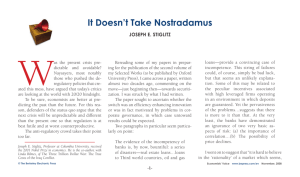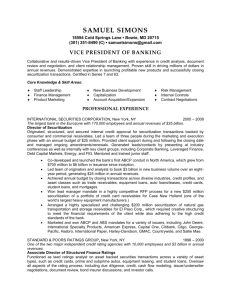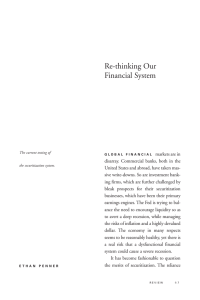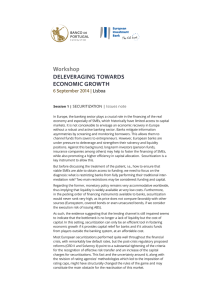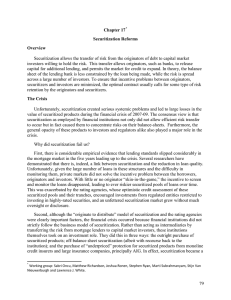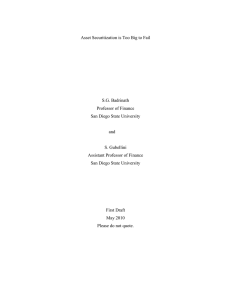Cass Business School
advertisement
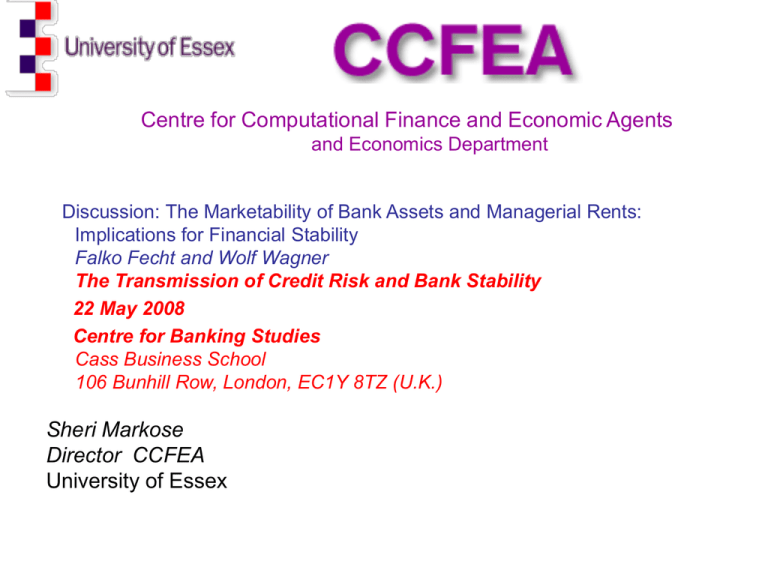
Centre for Computational Finance and Economic Agents and Economics Department Discussion: The Marketability of Bank Assets and Managerial Rents: Implications for Financial Stability Falko Fecht and Wolf Wagner The Transmission of Credit Risk and Bank Stability 22 May 2008 Centre for Banking Studies Cass Business School 106 Bunhill Row, London, EC1Y 8TZ (U.K.) Sheri Markose Director CCFEA University of Essex Main ingredients of the Fecht and Wagner (F&W) Paper • The main framework of paper is the ‘hold-up’ model of bank managers based on asymmetric information • Factors such as competitive loan market with ease of switching between lenders by borrowers and the ease of withdrawals by depositors (due to less than secure provision of deposit insurance) – all mitigate bank managerial extraction of monopoly rent in loan vs. deposit rates • F & W claim that their explanation goes beyond the ‘popular’ view (for lack of a precise provenance of this straw man) that originate and distribute process of bank loans resulted in reduced incentive by bank managers to screen and monitor and hence led to asset quality deterioration of assets retained on bank’s books The operational word is retained F&W claim the ‘popular’ model cannot explain “how banks have become more risky since the selling of risks should have made banks safer.” • Assets with the least risk are easier to securitize as the required coupon payments is less than what is commensurate with the default risk on riskier tranches In the ‘popular’ view, banks should find it too costly to pass on high risk sub prime loans, hence end up retaining them on their books The question is how were banks able to willy nilly pass on the subprime loans ? In other words what needs explaining is how so much bad stuff got passed on. The ‘popular’ answer: Default risk on these loans and hence costs to the bank for securitization in coupon payments and credit enhancement were under estimated . Was there excessive securitization ? It is not clear as F& W claim that banks became less safe as bad loans got passed on Bank failure was negligible in this subprime crisis ( April 2 2007 New Century Financial files for bankruptcy; some 100 mortgage providers followed. Compare this with the so called banking holocaust with 1000s of banks failing in the 1930s) Instead, massive losses of ABS were suffered by those to whom it was passed on viz: hedge funds, investment banks and institutional institutions For holders of MBS, write downs in excess of $300 bn As of April 2008, credit rating agencies had downgraded over $800 billion in highly-rated CDO and MBS, and more downgrades are expected. ) Estimate of total MBS is $1 Trillion Financial agents and Contagion F & W model: banks optimally use deposit rate to mitigate renegotiation problem and asset quality depends on managerial effort Returns c~ on the loan/project investment requiring $1 to be a uniform distribution With monitoring effort e= 1 Good state (cmax) and Bad (cmin) returns Without monitoring effort e = 0 Δc >0 asset quality loss is sustained through out ie. Good state return = cmax - Δc Bad state return = cmin - Δc Unfortunately, as a result the density of a uniform distribution is identical with and without monitoring Ф (0,1) = 1/ (cmax- cmin) Critical to the subprime crisis is the default probability on loans/project were ex ante different. Returns to agents • • • • Investors get return βc~ ( 0 ≤β < 1) Depositors get return D Equity/Managers get (1- β)c ~ F&W rely on exogenously given β return to investors to proxy for the marketability of assets and high β is meant to proxy the phenomena of securitization ( does β = 1 mean that 100% of bank loans are securitizited ?) When do managers stop monitoring ? The loss on return from zero effort Δc > G where G is the disutility or cost to manager for monitoring To cut to the chase: F&W claim there is a critical β0 above which when the managers expected incremental return falls below G, they cease to expend effort (eq. 15) c max c max c (1 0 ) c dc G Is the hold up framework of bank managers relevant to the recent credit crisis ? • F&W go on to say the β also proxies for market value of bank asset and as bank managers do not monitor for β0 < β < β^^, bank default probability increases and when β > β^^,banks will have zero default probability and perfect stability !! • How can high β > β0 market value for bank assets get determined with uniform asset quality deterioration as managers cease to monitor? • Curiously no model of securitization ie. what proportion of assets does a bank securitize? Is there an optimal level of securitization? Optimal securitization ratio (minimising capital injections/ maximising capital accumulation): Simon Wolfe (2000) Asset accumulation process with securitization: α = % of Asset securitzed; C(α ) : Cost of Securitization; (1-γ) : Default Rate on Assets At 1 (1 ) At At r A At M t C ( ) At C ( ) R C 2 R C capital injection/accumulation: Mt (1 )At (At Lt ) (1 )At Et if M > 0 capital injection is needed ; : capital adequacy ratio Figure I.5 Capital accumulation and α analysis I (T=5) (linear Cost) With linear costs note that as a higher and higher % of assets are securitized, a bank can keep improving its capital accumulation : The Money Pump model of Securitization Costs of MBS C ( ) RC 2 RC , RC is Coupon Rate on MBS. Citibank Report 2007 Sub-prime: Exploding ARM Capital Accumulation ra = 15% and rd = 3% (for BB-) ; ra= 11%; rd=3% (BB) ; ra= 7.5% , rd= 3% (BBB); ra = 5% rd = 3% (AA) Sub-prime Market MBS on Loan on Real Estate:Source FDIC WASHINGTON NEW CENTURY 2001.3 0.497971656 0.255255547 2001.6 0.427332242 0.236253407 2001.9 0.393723897 0.205321179 2001.12 0.302951192 0.180109436 2002.3 0.232911549 0.17544783 2002.6 0.198129305 0.218473105 2002.9 0.170938075 0.192971619 2002.12 0.155603184 0.157524953 2003.3 0.110635337 0.130638446 2003.6 0.071946644 0.109395568 2003.9 0.076294759 0.126652608 2003.12 0.052989651 0.122883974 2004.3 0.037408302 0.112385321 2004.6 0.038606 0.127830593 2004.9 0.035673732 0.134108553 Concluding Remarks • F&W model is ambiguous about what they mean by β, market value of ABS • Higher and higher values for ABS when asset quality is deteriorating is possible only if these assets are wrongly rated • ‘Hold up’ theory vs. popular theory of mispricing risk and reg. arb (Ambrose et. al (2003) • If costs of securitization are made to reflect default rates of 11% 15% (which grew to 33%) on sub prime loans, banks could not have passed them on as costs too exorbitant and close to zero advantage re. capital growth • If banks had to retain sub prime loans – they may not have generated them and the rate of securitization would have been modest rather than upto 50% of assets seen in early 2000 • ABS a substitute for bank equity; once that channel was defunct as ABS market values fell, pain suffered by banks is that of having to recapitalize • Pain suffered from contagion closer to $1 Trillion and possibly more Some References • Wolfe, Simon (2000), “Structural effects of asset-backed securitization”, The European Journal of Finance 6, pp353-369 • Sheri Markose, Yang Dong and Bewaji Oluwasegun , “An MultiAgent Model of RMBS, Credit Risk Transfer in Banks and Financial Stability: Implications for the Subprime Crisis”, Mimeo, Centre for Computational Finance and Economic Agents (CCFEA), University of Essex ,UK • Altman, Edward; Sreedhar T. Bharath, and Anthony Saunders (2004), “Credit Rating and the BIS Capital , Adequacy Reform Agenda” Forthcoming: Journal of Banking and Finance. • Ambrose, Brent W., LaCour-Little, Michael & Sanders, Anthony B. (2003), “Does Regulatory Capital Arbitrage or Asymmetric Information Drive Securitization?”, Journal of Financial Services Research,
